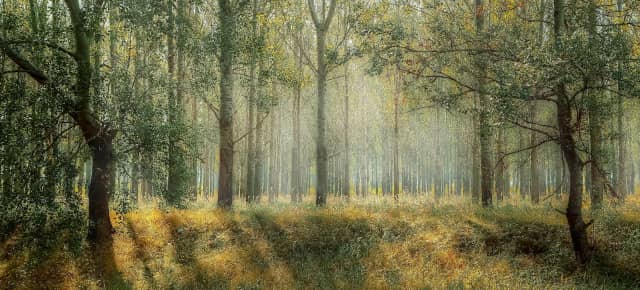What is the value of a forest? This article describes forest value in the light of economic valuation as a tool in environmental economics.
Where forests are being degraded in favor of other uses, planners and decision makers face the dilemma of whether their action is justified in terms of utility.
Is the destruction of the forest something that they can give up for the sake of so-called “progress”? How valuable is a forest? Is it alright to give it up for uses other than keeping it intact?
Answers to these questions will get clearer if we dissect what benefits we can derive from the forest as is as opposed to using it for other purposes.
Let’s see how valuable our forests are by considering what’s in there.
Forest Value: Timber Plus Other Likewise Important Uses
Forest value comes into question because, in reality, forests not only serve as a source of timber. There are non-timber products like honey, rattan, poles, charcoal and animals living in it that serve as food. We call these the non-timber forest products or NTFPs.
Besides these direct uses, there are also indirect uses like the forests serving as a watershed that provide a continuous flow of water to communities or even urbanized places. Forests prevent erosion of the uplands. Thus, siltation in low-lying rivers is avoided.
Looking at the functions of the forest, we know forests sequester or remove carbon from the atmosphere. This helps mitigate the impacts of global climate change.
People also find the forests nice to look at and give a premium to seeing it untouched. This is the reason many tourists prefer to go to places with intact forests.
Some groups of people would like the forests to exist as they were without them even seeing these forests.
Some desire that the enjoyment they derive from an intact forest will also be enjoyed by the next generation.
Others, especially the indigenous people, believe the forests are where their dead ancestors’ spirits live, and therefore should not be cut. They will even risk their lives, like the Chipko movement in India, who wrapped themselves around tree trunks, just to keep the loggers from cutting the trees down.
Non-Marketed Forest Value
This simply means that aside from the obvious marketed uses of forest products, there are also non-marketed forest values that could be gained without necessarily removing or extracting something from the forest. These are either the indirect uses or non-use values that are not usually incorporated in the conventional decision-makers’ feasibility studies. Incorporating the indirect and non-use values as part of the cost-benefit analysis would give a different picture of forest value, which is usually high.
When non-use value and other indirect benefits and social costs are incorporated in determining the total value of a resource, we refer to this as economic analysis.

Economic Analysis
How is economic analysis being done? This lies in the realm of environmental economics and the tools it uses to determine the value of environmental goods and services. Environmental economics applies the principles of economics to the study of how environmental resources are being managed. It looks into how and why individuals decide about the use and distribution of the environmental resources, in this case, the use and distribution of the forest resources.
Economic Valuation
It is not easy to measure the indirect and non-use values of a forest, but economists have come up with a system on how to do it. They call this economic valuation. Economic valuation is founded on the idea of people’s willingness-to-pay for such a good or service.
If people value something, then they are willing to pay to avail of it or keep it in existence. It is through this approximation of value that some amount could be imputed or given to particular goods or services.
Various techniques were devised by economists to measure forest value such as using travel costs incurred by tourists to enjoy the pristine scenery, contingent valuation method which measures how much the people are willing to pay to preserve a forest, or preventative approach where the people’s willingness to spend to prevent or avert forest fires, among others.
Total Economic Value
We can therefore estimate forest value using economic valuation. There are various techniques used to come up with some monetary estimates but the tool simply tries to sum up the total of the use (direct and indirect) and non-use values of say, in this discussion, a forest. Thus, it can be represented using the formula:
Total Economic Value = Use + Non-use Values
If all the use values and non-use values are listed and given specific monetary value, then it is easy for decision makers to comprehend how much a forest really costs and could balance their decisions regarding anything to replace the forest’s utility.
How Much is a Forest?
How much, then, is a forest? No straightforward answer could be given to such a question because forest value is contextual. It depends on that forest; its location, species diversity, size, stage of growth, among others. The more diverse it is, the greater the diversity of animal life that it could support, hence greater value would be given.
If the forest is growing along a slope, its erosion prevention value is higher than a forest growing on the plains. If the trees are still young, the forest can sequester more carbon in the atmosphere because young trees grow faster than old ones.
If we account not only for the direct benefits that could be gained from the forest, the forest value is very high.
According to Gretchen Daily, a Stanford economist, the forests of the world may well be worth trillions of dollars a year in terms of the goods and services it can sustainably provide. This just means that whatever plans or projects that will affect the integrity of the forest should be pondered with the utmost care. It is possible that the forest destroyed to give way to subdivisions could be the last remaining forest where a very effective cure for all kinds of cancer could have been found.
The forests of the world may well be worth trillions of dollars a year in terms of the goods and services it can sustainably provide.
Daily et al.
Other environmental resources of value are historic sites like old buildings, fortifications, structures, sites, or objects. To keep these resources from degradation, efforts are made by governments or concerned institutions to maintain them for generations, hence, appreciated for their significance. It must be kept safe from abuse by vandals and maintained to avoid unnecessary deterioration from the elements.
© 2023 January 25 P. A. Regoniel
Reference
Daily, G. C., Söderqvist, T., Aniyar, S., Arrow, K., Dasgupta, P., Ehrlich, P. R., … & Walker, B. (2000). The value of nature and the nature of value. Science, 289(5478), 395-396.
[cite]

